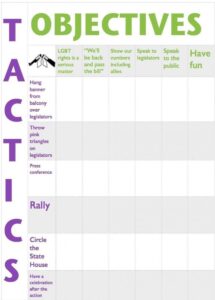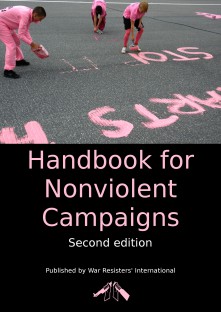Organizing Effective Actions
The following resources will help you organize effective actions. While all of these are also included in various training agendas, it is important for the organizers to understand them in order to prepare for trainings and actions.
- Dealing With Fear: Fear is a powerful emotion that can paralyze us or move us to act. We draw inspirational and practical resources on how to face our fears to become empowered to take a stand. They had to go through a process of dealing with fear. Here are videos, articles and exercises that can be used by individuals, in small groups and workshops.
- The video Nashville: We Were Warriors and the agenda for the Learning from the Nashville Campaign workshop are inspiring and helpful resources. More information on the Planning Nonviolent Campaigns page.
- Roles before, during and after an action
- The Affinity Groups and Consensus Decision-Making sections of the Handbook for Nonviolent Action
- Share information about legal rights, like National Lawyers Guild’s Know Your Rights, and Know Your Rights: A Guide for Protesters; and ACLU’s Know Your Rights: Protesters Rights; The Center for Constitutional Rights’ If An Agent Knocks and National Lawyers Guild’s Federal Defense Hotline.
- Legal support includes tasks to do before and during an action as well as after arrests. The Legal Issues/Risking Arrest/Representing Yourself sections of the Handbook for Nonviolent Action include a helpful Legal Systems Flowchart which can be downloaded as a handout. Another version of the flowchart is here.
- Action evaluation | This section allows us to learn from our experiences and is important to strengthen out campaigns.
Organizers should work with nonviolence trainers

Nonviolence training helps prepare participants for effective nonviolent actions.
Organizers + trainers need to work together to make sure that trainings meet the need of those being trained. See Tasks and Tools for organizing a training to prepare!
Match tactics for a specific action with the campaign objectives.
The Matrix exercise is a helpful tool when group has not fully decided on action plans.
The Cross spectrum can help a group determine what is effective nonviolent action and to develop a nonviolent action scenario.
Handbooks
These resources on the Nonviolent Action pages include links to specific handouts, exercises and resources. Additional resources are available in a number of handbooks.
The 2nd edition of the Handbook for Nonviolent Campaigns (2014) is nearly out of print. You can access it online here. We are working on a format that will be more conducive to printing individual sections. While they last the paperback is for sale from our store.
The 1st edition of the Handbook for Nonviolent Campaigns (2009) has online versions in English and Spanish organized by chapter. You can purchase a copy of the paperback from our store.
War Resisters League’s Handbook for Nonviolent Action (1989), a 34 page booklet first printed in 1989, is quite dated in some of its language, particularly in the sections on oppression in the second half. However, the front includes helpful description of affinity groups, consensus decision making, a legal flow chart, etc. It can be purchased on our store, and can be found at the Digital Library of Nonviolent Resistance at the Rutgers International Institute for Peace.
Share

